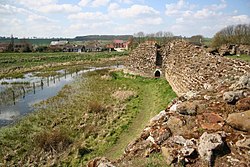Old Bolingbroke
| Old Bolingbroke | |
| Lincolnshire | |
|---|---|
 Old Bolingbroke | |
| Location | |
| Grid reference: | TF348651 |
| Location: | 53°9’60"N, -0°-0’58"E |
| Data | |
| Population: | 298 (2001) |
| Postcode: | PE23 |
| Local Government | |
| Council: | East Lindsey |
| Parliamentary constituency: |
Louth and Horncastle |
Bolingbroke, now called Old Bolingbroke, is a village near Spilsby in Lincolnshire. The village of New Bolingbroke lies six miles to the south-west. The Greenwich Meridian passes to the west of Old Bolingbroke.
The village sits in a broad valley of the Lincolnshire Wolds, between two streams, that rise in the surrounding hills. These eventually become what is known to the south as Hagnaby Beck.
Bolingbroke appears in the Domesday Book of 1086 as Bolingborc;[1] one of 38 places associated with Stori of Bolingbroke at the time of the Norman Conquest.
Bolingbroke Castle

William de Roumare, Earl of Lincoln (born circa 1096), may have built Bolingbroke Castle in the 12th century as a motte and bailey castle with wet ditch, to replace an earlier earthwork defence structure which overlooked the village on Dewy Hill. In the early 13th century, a new castle was constructed at the present site by Ranulph de Blondeville, 4th Earl of Chester following his return in 1220 from the 5th Crusade. Later John of Gaunt, the son of King Edward III, acquired the castle through his wife, Blanche of Lancaster. In 1367 it was the birthplace of John's son, Henry, known as Henry Bolingbroke, who became King Henry IV of England.
The parish church of Old Bolingbroke was rebuilt by Alice de Lacy and John of Gaunt.
In 1643 during the Civil War, the church was significantly damaged during the siege of the castle, when the Royalists used the castle to garrison troops before the Battle of Winceby (fought on 11 October 1643).
The last remaining castle structure fell down in 1815. The site became a grassy hillock, which archaeologists excavated in the 1970s.[2][3]
Churches
The parish church, St Peter and St Paul, is part of the Spilsby, Marden Hill, Stickney & Partney Group Parishes in the Deanery of Bolingbroke..[4] There is a second church in the parish, in Hareby, also named St Peter and St Paul.
The village's Methodist Chapel in Chapel Lane was built in 1845.[5] It is part of the Mid Lincolnshire Circuit.[6]
-
Church of Saints Peter & Paul
-
Interior of the Church of Saints Peter & Paul
-
Methodist chapel, built in 1845
-
Street party in West Keal Road to celebrate the Wedding of Prince William and Catherine Middleton
Community
Events at the castle site are overseen by Heritage Lincolnshire, and locally by 'The Friends of Bolingbroke Castle', who also arrange other local charitable functions.[7]
The Parish Council own and maintain the King George V Playing Field and the Ramsden Village Hall, the latter named for John and Eleanor Ramsden who bequeathed the land used for both to the village in 1937.[8]
Outside links
| ("Wikimedia Commons" has material about Old Bolingbroke) |
- History of Bolingbroke, in East Lindsey and Lincolnshire: A Vision of Britain through Time
- Canfield, C. P. (August 2009). "OLD BOLINGBROKE, St. Peter & St. Paul (TF 349 652)". English Church Architecture - Lincolnshire.. http://english-church-architecture.net/lincolnshire/old%20bolingbroke/old_bolingbroke.htm. Retrieved 3 October 2013.
References
- ↑ Bolingbroke Old Bolingbroke in the Domesday Book
- ↑ National Monuments Record: No. 354204 – Bolingbroke Castle
- ↑ National Monuments Record: No. 354204 – Battle of Winceby
- ↑ "Spilsby, Marden Hill, Stickney & Partney Group Parishes". Spilsby Area Parishes. 2013. http://lincoln.ourchurchweb.org.uk/spilsby/. Retrieved 2 October 2013.
- ↑ Stell, Christopher (2002). Nonconformist Chapels and Meeting-houses in Eastern England. English Heritage. p. 198. ISBN 978-1873592502.
- ↑ "Mid Lincolnshire Methoist Circuit". The Methodist Church. 2009. http://midlincs.org.uk/. Retrieved 3 October 2013.
- ↑ "Friends of Bolingbroke Castle". Lincolnshire county council. http://www.lincolnshire.gov.uk/OrganisationDetails.aspx?orgcode=5014. Retrieved 2 October 2013.
- ↑ "Old Bolingbroke The Ramsden Village Hall". Lincolmshire county council. http://www.lincolnshire.gov.uk/VenueDetails.aspx?venuecode=23069. Retrieved 2 October 2013.
- Nikolaus Pevsner: The Buildings of England: Lincolnshire, 1964; 1989 Penguin Books ISBN 978-0-300-09620-0pages 330–331
- Frampton, David; Garnham, Peter. The Battle of Winceby 1643.
- "Battle of Winceby 11th October 1643". Battlefield resource centre. The Battlefield Trust. http://www.battlefieldstrust.com/resource-centre/civil-war/battleview.asp?BattleFieldId=48. Retrieved 3 October 2013.



